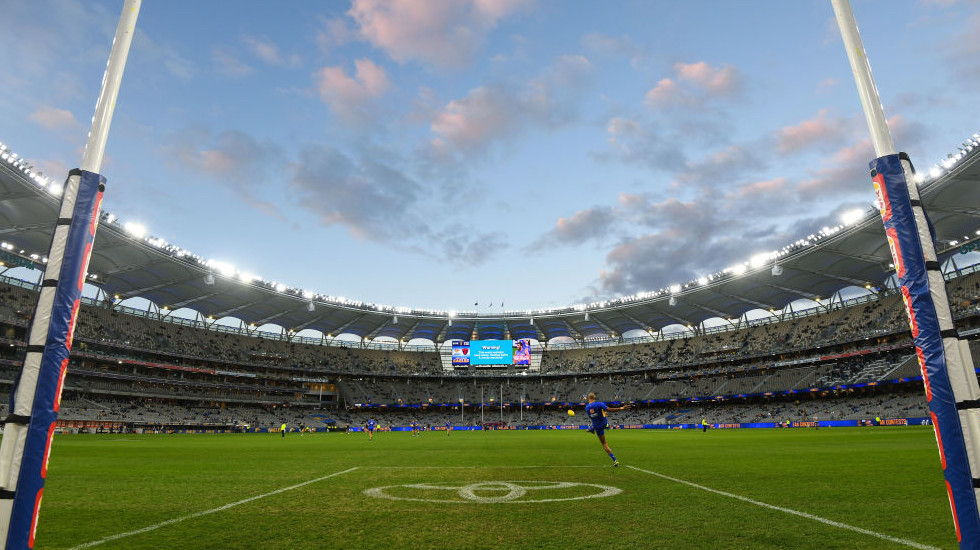West Coast’s Lewis Jetta practices a kick-in before last week’s game against Melbourne at Optus Stadium. Photo: AFL MEDIA
We spend far more time these days talking about how AFL football looks than we used to. And so we should.
Never has the game changed appearance more dramatically than over the past two decades or so. To the point where a match played in the mid-1990s can in some cases barely resemble the same sport as one from 2019.
Whether that’s good or bad is all subjective. And depends what you value about the game. But what can’t be disputed are the trends. One of which I don’t think is receiving nearly enough attention.
Recently on social media I saw posted snapshots of two final scoreboards. One was from a game acclaimed as a home and away classic, Hawthorn’s comeback win over Geelong at Princes Park in 1989. The other was from this year’s round seven clash between Adelaide and Fremantle. Both games were played in fine conditions. But one contrast was stark indeed.
The Hawks in 1989 had run down a deficit of at one stage 53 points against the Cats, the final scoreline 26.15 (171) to 25.13 (163). The two teams would go on to almost reprise that game on grand final day, this time with an aggregate of 42 goals.
Many people, including my Footyology podcast colleague Mark Fine believed Adelaide’s 17-point win over the Dockers a few weeks back was also for different reasons a terrific game, encompassing the tremendous defensive pressure and strategies which are a hallmark of football today. It finished with a scoreline of 7.9 (51) to 5.4 (34). That’s some difference.
Scoring, or lack of it, is a hot-button issue of the moment, not surprisingly given last year was the lowest-scoring season we’d seen since 1968, and that despite the much-vaunted rule changes this season, including the 6-6-6 formation at centre bounces, it is down again so far in 2019, that modest average of 83 points per team having dropped further to a current 80.
But is this just about scoring? I’m not convinced. Increasingly, I think much of the disquiet and concerns many express about how the game is played now aren’t simply about the numbers of goals that are scored, but how they are being scored.
When football lovers (including me) watch and talk about matches of the past, it’s easiest to cite the scores as evidence of a more free-flowing, attacking style of game. What isn’t as easily quantifiable for the average fan, though, is the way the ball rebounds from end to end, as one team, then the other, transitions from defence to attack.
Here’s an example. I’ve long proclaimed the 1994 preliminary final classic between Geelong and North Melbourne (won for the Cats by Gary Ablett senior after the siren) the greatest game of football I have ever seen.
It featured wild swings of fortune and scoring by either team, and finished 16.13 (109) to 14.19 (103). But that is only a fraction of the story, those scores merely par for the course in that era. In fact, the epic final quarter contained just four goals, and just one, kicked after the bell, by the team which won the game.
What makes the last quarter of that classic so breathtaking to watch is the constant swing of the ball from one end to the other, Geelong and North Melbourne attacking and counter-attacking at speed, defence becoming attack in an instant in sweeping, “coast-to-coast” chains of play.
For me, that has been a bigger loss than any scoring per se. And the numbers concerning it are just as alarming, not even going back the 25 years since that game was played, but even just the last 10.
While even those who bemoan the continued drop in scores concede 6-6-6 has made centre bounces at least a lot cleaner and more open, another of the new rules, increasing the space around the player kicking in from a behind, has had no benefits whatsoever. In fact, quite the reverse.
At the end of last year, Champion Data’s scoring sources reports showed that scores from turnovers were on average 60.5 per cent of all scores, while 35.5 per cent were coming from clearances, and just four per cent from kick-ins.
Since 2005, the percentage of turnover scores has stayed roughly around the same mark, while scores from clearances have increased marginally. It’s scores from the kick-in which has seen the most dramatic decline. In 2007, they comprised 7.7 per cent of all scores. Currently, they are just 3.7 per cent, less than half that figure of 12 years ago.
Small wonder coaches have invested little time devising techniques to exploit the new kick-in rule when it is working on their teams’ stoppage craft and capacity to score from intercepts that is so much more profitable.
It’s not just about kick-ins or scoring from them, either. Simply even transitioning the ball from the defensive 50-metre arc to the attacking one has become progressively more difficult as sides have become expert at the forward press and locking the ball inside their scoring zones.
In 2007, no fewer than 37 per cent of unbroken chains of play from inside the defensive 50 were ending up in the forward 50, while nearly 17 per cent of them were ending up as a score.
By 2012, those percentages had fallen to around 23 and 10 respectively, and they’ve continued to decline slowly but surely. After nine rounds of 2019, the equivalent percentages were 20.1 and 8.5. In other words, just on half as often now are we seeing the ball even simply carried by one team from one 50-metre zone to the other as was the case only a dozen years ago.
So far this season, it’s not just scores from kick-ins which have fallen, but turnover scores as well. And some club insiders believe the new kick-in rule has a lot to do with both fall-offs.
The extra space hasn’t tempted teams kicking in to explore more options in attempting to get to the other end, simple ball retention seen as more important than ever. And the pushing of players defending kick-ins back another 10 metres has made it harder to score from intercepted kick-ins.
That’s two downturns from a rule which was supposed to provide an upswing in coast-to-coast scores. Woops, one might say.
There’s still plenty of time of course for coaches to try something a bit bolder than chipping the ball around the half-back line looking for a way through the maze. But so far the signs aren’t promising. Even less so if you study the last 10 years of football.
Football’s continued evolution has meant we’ve never really known what might be around the corner, and over the last decade, we’ve seen the precision kicking of Alastair Clarkson’s Hawthorn teams, the forward presses of St Kilda then Collingwood, the Bulldogs’ “handball club” and Richmond’s forward swarm.
But a theme common to all has been intense forward half pressure, too many players crammed into one small section of the ground, that theme merely repeated at the other end when the ball finally escapes.
If you were to break it down into a sort of morse code of patterns of play it might read: scramble, scramble, scramble, break, scramble, scramble, scramble, break … and so on.
Of course there are still great games, last year’s grand final as good as any the modern era has seen. Are they more the exception than the rule these days, though? Sadly, I’m starting to think so.
Perhaps the longer the way the modern game is being played becomes entrenched, the more we’ll accept its highs and lows in their own right rather than continue pursuing attempts at “solutions” which to date either haven’t worked or, worse, have actually had an adverse impact.
But it’s difficult whilst the memory of what was is still fresh enough in the minds of those who experienced it. And with the numbers to prove those contentions aren’t just the donning of rose-coloured glasses.
We need to keep talking about how the game looks. Because I think we’re now well past the stage where any natural evolution is going to take care of things on its own. Elite defensive mechanisms and suffocating forward pressure are firmly entrenched in the modern game. Rule changes seem to be doing little to thwart their dominance.
And while I can live with lower scores, fewer high marks and more bodies clustered around the football, if the game continues to lose even just its capacity for play to switch quickly from one end of the ground to the other, I’m not sure there’s much left over which is all that special.
*This article first appeared at INKL.











